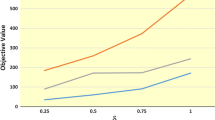Abstract
Geometric programming is a well-known optimization tool for dealing with a wide range of nonlinear optimization and engineering problems. In general, it is assumed that the parameters of a geometric programming problem are deterministic and accurate. However, in the real-world geometric programming problem, the parameters are frequently inaccurate and ambiguous. To tackle the ambiguity, this paper investigates the geometric programming problem in an uncertain environment, with the coefficients as triangular and trapezoidal twofold uncertain variables. In this paper, we introduce uncertain measures in a generalized version and focus on more complicated twofold uncertainties to propose triangular and trapezoidal twofold uncertain variables within the context of uncertainty theory. We develop three reduction methods to convert triangular and trapezoidal twofold uncertain variables into singlefold uncertain variables using optimistic, pessimistic, and expected value criteria. Reduction methods are used to convert the geometric programming problem with twofold uncertainty into the geometric programming problem with singlefold uncertainty. Furthermore, the chance-constrained uncertain-based framework is used to solve the reduced singlefold uncertain geometric programming problem. Finally, a numerical example is provided to demonstrate the effectiveness of the procedures.












Similar content being viewed by others
Data availability
Data sharing is not applicable to this article as no datasets were generated. A random data set is taken for the numerical example given in this paper.
References
Avriel, M., Dembo, R., Passy, U.: Solution of generalized geometric programs. Int. J. Numer. Method Eng. 9, 149–168 (1975)
Avriel, M., Wilde, D.J.: Engineering design under uncertainty. I &EC Process Des. Dev. 8, 127–131 (1969)
Beightler, C.S., Phillips, D.T.: Applied Geometric Programming. Wiley, New York (1976)
Cao, B.Y.: Extended fuzzy geometric programming. J. Fuzzy Math. 1, 285–293 (1993)
Cao, B.Y.: Research for a geometric programming model with T-fuzzy variable. J. Fuzzy Math. 5, 625–632 (1997)
Chassein, A., Goerigk, M.: On the complexity of robust geometric programming with polyhedral uncertainty. Oper. Res. Lett. 47, 21–24 (2019)
Cheng, T.C.E.: An economic order quantity model with demand-dependent unit production cost and imperfect production process. IIE Trans. 23, 23–28 (1991)
Chiang, M.: Geometric programming for communication systems. Found. Trends Commun. Inf. Theory. 2, 1–154 (2005)
Choi, J.C., Bricker, D.L.: Effectiveness of a geometric programming algorithm for optimization of machining economics models. Comput. Oper. Res. 10, 957–961 (1996)
Chu, C., Wong, D.F.: VLSI circuit performance optimization by geometric programming. Ann. Oper. Res. 105, 37–60 (2001)
Duffin, R.J., Peterson, E.L., Zener, C.M.: Geometric Programming Theory and Applications. Wiley, New York (1967)
Duffin, R.J., Peterson, E.L.: Geometric programming with signomials. J. Optim. Theory Appl. 11, 3–35 (1973)
Fang, S.C., Peterson, E.L., Rajasekera, J.R.: Controlled dual perturbations for posynomial programs. Eur. J. Oper. Res. 35, 111–117 (1988)
Fontem, B.: Robust chance-constrained geometric programming with application to demand risk mitigation. J. Optim. Theory Appl. 197, 765–797 (2023)
Gupta, N.C.D., Paul, H., Yu, C.H.: An application of geometric programming to structural design. Comput. Struct. 22, 965–971 (1986)
Hershenson, M.D., Boyd, S.P., Lee, T.H.: Optimal design of a CMOS op-amp via geometric programming. IEEE Trans. Comput. Aid. Des. 20, 1–21 (2001)
Islam, S., Roy, T.K.: Fuzzy multi-item economic production quantity model under space constraint: a geometric programming approach. Appl. Math. Comput. 184, 326–335 (2007)
Jung, H., Klein, C.M.: Optimal inventory policies under decreasing cost functions via geometric programming. Eur. J. Oper. Res. 132, 628–642 (2001)
Kim, D., Lee, W.J.: Optimal joint pricing and lot sizing with fixed and variable capacity. Eur. J. Oper. Res. 109, 212–227 (1998)
Kortanek, K.O., No, H.: A second order affine scaling algorithm for the geometric programming dual with logarithmic barrier. Optimization 23, 303–322 (1992)
Kortanek, K.O., Xu, X., Ye, Y.: An infeasible interior-point algorithm for solving primal and dual geometric programs. Math. Program. 76, 155–181 (1997)
Lee, W.J.: Determining order quantity and selling price by geometric programming. Optimal solution, bounds, and sensitivity. Decis. Sci. 24, 76–87 (1993)
Liu, B.: Uncertainty Theory, 4th edn. Springer, Berlin (2015)
Liu, J., Peng, S., Lisser, A., Chen, Z.: Rectangular chance constrained geometric optimization. Optim. Eng. 21, 537–566 (2020)
Liu, S.T.: Geometric programming with fuzzy parameters in engineering optimization. Int. J. Approx. Reason. 46, 484–498 (2007)
Liu, S.T.: Posynomial geometric programming with parametric uncertainty. Eur. J. Oper. Res. 168, 345–353 (2006)
Mahapatra, G.S., Mandal, T.K.: Posynomial parametric geometric programming with interval valued coefficient. J. Optim. Theory Appl. 154, 120–132 (2012)
Mandal, N.K., Roy, T.K.: A displayed inventory model with L-R fuzzy number. Fuzzy Optim. Decis. Mak. 5, 227–243 (2006)
Maranas, C.D., Floudas, C.A.: Global optimization in generalized geometric programming. Comput. Chem. Eng. 21, 351–369 (1997)
Mondal, T., Ojha, A.K., Pani, S.: Solving geometric programming problems with triangular and trapezoidal uncertainty distributions. RAIRO-Oper. Res. 56, 2833–2851 (2022)
Passy, U., Wilde, D.J.: A geometric programming algorithm for solving chemical equilibrium problems. SIAM J. Appl. Math. 16, 363–373 (1968)
Rajgopal, J.: An alternative approach to the refined duality theory of geometric programming. J. Math. Anal. Appl. 167, 266–288 (1992)
Rajgopal, J., Bricker, D.L.: Posynomial geometric programming as a special case of semi-infinite linear programming. J. Optim. Theory Appl. 66, 455–475 (1990)
Rajgopal, J., Bricker, D.L.: Solving posynomial geometric programming problems via generalized linear programming. Comput. Optim. Appl. 21, 95–109 (2002)
Roy, T.K., Maiti, M.: A fuzzy EOQ model with demand-dependent unit cost under limited storage capacity. Eur. J. Oper. Res. 99, 425–432 (1997)
Ruckaert, M.J., Martens, X.M., Desarnauts, J.: Ethylene plant optimization by geometric programming. Comput. Chem. Eng. 2, 93–97 (1978)
Scott, C.H., Jefferson, T.R.: Allocation of resources in project management. Int. J. Syst. Sci. 26, 413–420 (1995)
Shiraz, R.K., Khodayifar, S., Pardalos, P.M.: Copula theory approach to stochastic geometric programming. J. Glob. Optim. 81, 435–468 (2021)
Shiraz, R.K., Tavana, M., Di Caprio, D., Fukuyama, H.: Solving geometric programming problems with normal, linear and zigzag uncertainty distributions. J. Optim. Theory Appl. 170, 243–265 (2016)
Shiraz, R.K., Tavana, M., Fukuyama, H., Di Caprio, D.: Fuzzy chance-constrained geometric programming: the possibility, necessity and credibility approaches. Oper. Res. Int. J. 17, 67–97 (2017)
Shiraz, R.K., Fukuyama, H.: Integrating geometric programming with rough set theory. Oper. Res. Int. J. 18, 1–32 (2018)
Sinha, S.B., Biswas, A., Biswal, M.P.: Geometric programming problems with negative degrees of difficulty. Eur. J. Oper. Res. 28, 101–103 (1987)
Wall, T.W., Greening, D., Woolsey, R.E.D.: OR practice-solving complex chemical equilibria using a geometric-programming based technique. Oper. Res. 34, 345–493 (1986)
Worrall, B.M., HALL, M.A.: The analysis of an inventory control model using posynomial geometric programming. Int. J. Prod. Res. 20, 657–667 (1982)
Yang, J.H., Cao, B.Y.: Monomial geometric programming with fuzzy relation equation constraints. Fuzzy Optim. Decis. Mak. 6, 337–349 (2007)
Yang, L., Liu, P., Li, S., Gao, Y., Ralescu, D.A.: Reduction methods of type-2 uncertain variables and their applications to solid transportation problem. Inf. Sci. 291, 204–237 (2015)
Acknowledgements
The authors are extremely thankful to the editor and anonymous reviewers for their insightful comments and suggestions. The first author is thankful to CSIR for financial support of this work through file No: 09\1059(0027)\2019-EMR-I.
Author information
Authors and Affiliations
Corresponding author
Ethics declarations
Conflict of interest
The authors have no relevant financial or non-financial interests to disclose. The authors declare that they have no conflict of interests.
Additional information
Communicated by Ana Luisa Custodio.
Publisher's Note
Springer Nature remains neutral with regard to jurisdictional claims in published maps and institutional affiliations.
Rights and permissions
Springer Nature or its licensor (e.g. a society or other partner) holds exclusive rights to this article under a publishing agreement with the author(s) or other rightsholder(s); author self-archiving of the accepted manuscript version of this article is solely governed by the terms of such publishing agreement and applicable law.
About this article
Cite this article
Mondal, T., Ojha, A.K. & Pani, S. Geometric Programming Problems with Triangular and Trapezoidal Twofold Uncertainty Distributions. J Optim Theory Appl 200, 978–1016 (2024). https://doi.org/10.1007/s10957-023-02347-5
Received:
Accepted:
Published:
Issue Date:
DOI: https://doi.org/10.1007/s10957-023-02347-5
Keywords
- Geometric programming
- Triangular twofold uncertain variable
- Trapezoidal twofold uncertain variable
- Reduction method




